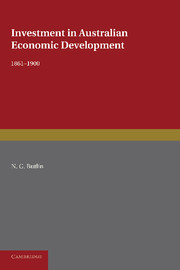Book contents
- Frontmatter
- Contents
- LIST OF TABLES
- LIST OF TEXT-FIGURES
- LIST OF PLATES
- Preface
- PART A INTRODUCTION
- PART B THE PRIVATE SECTOR
- CHAPTER II INVESTMENT IN RURAL DEVELOPMENT
- CHAPTER III INVESTMENT IN URBANISATION I: URBANISATION AND INDUSTRIAL DEVELOPMENT
- CHAPTER IV INVESTMENT IN URBANISATION II: THE GROWTH OF RESIDENTIAL REAL ESTATE
- PART C THE PUBLIC SECTOR
- PART D STRUCTURAL READJUSTMENT
- Appendix I Revision of N.S.W. Residential Investment 1905/06-1911/12
- Appendix II Australian Domestic Product, Investment and Foreign Borrowing, 1861-1938/39.
- Bibliography
- Index
CHAPTER III - INVESTMENT IN URBANISATION I: URBANISATION AND INDUSTRIAL DEVELOPMENT
from PART B - THE PRIVATE SECTOR
Published online by Cambridge University Press: 05 June 2016
- Frontmatter
- Contents
- LIST OF TABLES
- LIST OF TEXT-FIGURES
- LIST OF PLATES
- Preface
- PART A INTRODUCTION
- PART B THE PRIVATE SECTOR
- CHAPTER II INVESTMENT IN RURAL DEVELOPMENT
- CHAPTER III INVESTMENT IN URBANISATION I: URBANISATION AND INDUSTRIAL DEVELOPMENT
- CHAPTER IV INVESTMENT IN URBANISATION II: THE GROWTH OF RESIDENTIAL REAL ESTATE
- PART C THE PUBLIC SECTOR
- PART D STRUCTURAL READJUSTMENT
- Appendix I Revision of N.S.W. Residential Investment 1905/06-1911/12
- Appendix II Australian Domestic Product, Investment and Foreign Borrowing, 1861-1938/39.
- Bibliography
- Index
Summary
STIMULI FOR URBAN DEVELOPMENT
In Western experience of the past 200-300 years, highly urban societies have emerged in transition from predominantly agrarian activities to industrial-commercial specialisation. Whatever other influences may have been at work, this evolution has occurred through regional specialisation and trade, the development of farm crafts, the appearance of a surplus agricultural population and the increase in agricultural productivity; and the expansion of specialised secondary and tertiary activities has further increased rural productivity and speeded the relative decline of rural populations.
No doubt Australian settlement could be treated as an extension of this Western experience. But, in itself, the story of urban growth in Australian history does not fit this tradition. There was some industrial activity in the Australian colonies of 1860, but it accounted for a mere 5 % of total output. Yet Australia was already, in 1860, a highly urban society. In the three eastern mainland colonies, Queensland, N.S.W. and Victoria, as many as 40 % of the people lived in towns. However, this urbanisation was carried very much further during the years 1860-1900, to lay the basic pattern of the modern highly urbanised Australian community. As early as 1891, this new and underdeveloped area had succeeded in carrying urbanisation to a degree which was rare in the rest of the world. Almost two-thirds of the population of 1891 lived in towns and cities, a proportion which was not matched by other ‘ new’ countries, particularly the United States, until 1920, and Canada until 1950.
This urbanisation during 1860-1900 was accompanied by a basic re-orientation of the economy. At least until 1890, total population grew rapidly, at a rate well ahead of that in the rest of the world. Total output rose at much the same rate and, at the same time, the rate of capital accumulation accelerated. The expansion of output and capital occurred by way of a profound structural change, with rapid growth of capital equipment in communications, pastoral activity, residential facilities, commercial enterprise and manufacturing and with a pronounced shift in the composition of output towards commercial-industrial specialisation. Rapid urbanisation occurred in the context of this structural change. The disposal and finance of a rapidly rising export trade and the distribution of goods demanded by a rapidly growing and widely scattered population provided the opportunities for commercial and financial enterprise.
- Type
- Chapter
- Information
- Investment in Australian Economic Development, 1861–1900 , pp. 181 - 210Publisher: Cambridge University PressPrint publication year: 2013



